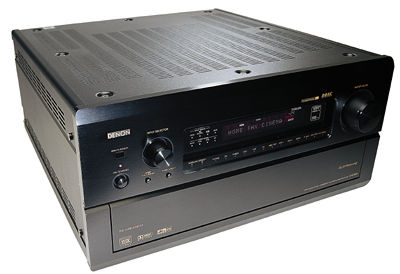Denon AVR-5800 A/V receiver

What it Does
The AVR-5800 is the first receiver to offer DTS-ES Discrete 6.1, which puts a discrete (not matrixed, or derived from the L/R rear) center channel behind you. Few films so far are so encoded, but don't worry—as already noted, the Denon also decodes every other surround format known. Denon points out that, in DTS-ES Matrix 6.1 mode, the 5800 uses a specific logic matrix developed by DTS, not the generic one that they claim other receivers use.
The Denon also features 24-bit/192kHz D/A converters and a powerful 7-channel amplifier section. Sixteen of the latest Analog Devices AD-1853 24-bit/192kHz converters are used in dual-differential pairs for the lowest possible noise and widest dynamic range. When there's a need to convert analog signals to the digital domain, 24-bit/96kHz A/D converters are also used. Digital signal processing and all surround-sound decoding are handled by the latest Analog Devices SHARC Dual 32-bit Floating Point DSPs, each of which is capable of processing 80 megaFLOPS (millions of floating point operations per second) at a rate of 50 MIPS (millions of instructions per second).
There are seven 170W amplifiers, each rated at 8ohms from 20Hz to 20kHz at 0.05% THD. The THX Ultra logo means that the AVR-5800's amps, which use high-current, low-impedance discrete power transistors, are certified to produce rated power at impedances down to 3.2ohms. This ensures rated power into real-world speaker loads, whose impedances can vary with frequency.
Of course, the 5800 offers the full complement of THX processing, including timbre matching, re-equalization, and dynamic decorrelation. In other words, at least with respect to the features needed to optimize movie watching on a home-theater system, the 5800 is clearly state-of-the-art.
The AVR-5800 also includes a host of features designed to enhance listening to music in 2-channel and multichannel configurations. When operated in the 2-channel Direct and Pure Direct modes, the 5800 features 24-bit ALPHA processing. Also known as AL24, this process interpolates 24 bits from standard 16-bit digital material, which is said to create a more accurate analog waveform at the output of the D/A converters and, presumably, improved sound. My listening to this and earlier Denon products that used this technology backs this claim up. In Pure Direct, all video circuitry and power to the front-panel display is turned off so that neither interferes with the purity of the incoming signal. When the input is a linear PCM signal, the DACs are reconfigured to operate as eight dual-differential DACs (four per channel) for the utmost transparency and dynamic range.
If you plug an analog (gasp!) source into the AVR-5800—a turntable or perhaps the analog outputs of an SACD player—the signal is delivered to the amplifiers in the analog domain without any A/D and D/A conversion. Furthermore, when the input is analog, power to the digital section is turned off. The attention paid by Denon in their attempt to get a complex multichannel receiver to behave like a high-performance, 2-channel, high-end audio product is, in my experience, unprecedented.
Denon also offers a separate set of rear-channel outputs so you can optimize the placement of a pair of speakers just for music surround. Just think: "Hey honey, look! That pair of speakers is for the surround channels, that pair is for the center surround, and that pair over there is just for listening to surround-sound music—six speakers in the back of our living room and three in front, plus that big ol' subwoofer! Isn't that special?"
The AVR-5800 also offers flexible multi-zone operation, complete control over delay times, 40-station auto tuning of the sensitive, fine-sounding AM/FM tuner, separate level adjustments for each surround mode, and much more. A fader function allows you to reduce all three front or all the rear speakers simultaneously so you can balance multichannel music recordings from any listening position. This is important: Most multichannel music recordings are mixed under the assumption that the listener will be seated equidistant from the front and rear channels. Home-theater mixes are optimized differently.
- Log in or register to post comments




































































